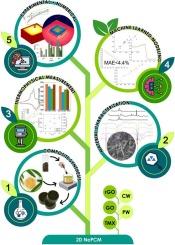基于二维纳米颗粒的巴西棕榈蜡纳米复合材料热物理性能的实验与数值研究
IF 10.9
1区 工程技术
Q1 ENERGY & FUELS
引用次数: 0
摘要
对可持续能源储存的需求日益增长,促使相变材料的发展具有更好的热性能和环境相容性。石油基相变材料,如石蜡,提供高效率,但不可生物降解,需要生物基替代品,如巴西棕榈蜡。本研究通过将还原氧化石墨烯、氧化石墨烯和Ti3C2Tx MXene等二维纳米颗粒分散到巴西棕榈和石蜡基体中,引入纳米颗粒增强相变材料,以改善其热流变行为。纳米颗粒增强相变材料以0.1-0.5 wt%的纳米颗粒负载合成,并使用x射线衍射、傅里叶变换红外光谱、差示扫描量热法、粘度测量和导热分析进行表征,同时使用机器学习建立预测模型,并通过计算流体动力学模拟进行验证。棕榈基复合材料的导热系数提高了20.4%,石蜡基复合材料的导热系数提高了19.6%,而潜热降低分别限制在13.3%和9.3%。机器学习模型再现实验结果的准确率为96.7%,数值模拟证实对流换热的改善高达19.98%。这些发现确立了棕榈纳米颗粒增强相变材料作为石蜡基体系的可持续替代品,结合了生物可降解性和具有竞争力的热物理性能,可用于下一代能源和冷却应用。本文章由计算机程序翻译,如有差异,请以英文原文为准。

Experimental and numerical study of thermophysical properties of carnauba wax nanocomposites with two-dimensional nanoparticles for sustainable thermal energy storage
The increasing demand for sustainable energy storage has intensified the development of phase change materials with improved thermal performance and environmental compatibility. Petroleum-based phase change materials, such as paraffin wax, provide high efficiency but are non-biodegradable, necessitating bio-based alternatives such as carnauba wax. This study introduced nanoparticle-enhanced phase change materials by dispersing two-dimensional nanoparticles like reduced graphene oxide, graphene oxide, and Ti3C2Tx MXene into carnauba and paraffin wax matrices to improve thermal and rheological behavior. Nanoparticle-enhanced phase change materials were synthesized with nanoparticle loadings of 0.1–0.5 wt% and characterized using X-ray diffraction, Fourier transform infrared spectroscopy, differential scanning calorimetry, viscosity measurements, and thermal conductivity analysis, while predictive models were developed using machine learning and validated through computational fluid dynamics simulations. Thermal conductivity enhancements reached 20.4% in carnauba-based composites and 19.6% in paraffin-based composites, while latent heat reductions were limited to 13.3% and 9.3%, respectively. Machine learning models reproduced experimental results with 96.7% accuracy, and numerical simulations confirmed convective heat transfer improvements of up to 19.98%. These findings establish carnauba-based nanoparticle-enhanced phase change materials as sustainable alternatives to paraffin-based systems, combining biodegradability with competitive thermophysical performance for next-generation energy and cooling applications.
求助全文
通过发布文献求助,成功后即可免费获取论文全文。
去求助
来源期刊

Energy Conversion and Management
工程技术-力学
CiteScore
19.00
自引率
11.50%
发文量
1304
审稿时长
17 days
期刊介绍:
The journal Energy Conversion and Management provides a forum for publishing original contributions and comprehensive technical review articles of interdisciplinary and original research on all important energy topics.
The topics considered include energy generation, utilization, conversion, storage, transmission, conservation, management and sustainability. These topics typically involve various types of energy such as mechanical, thermal, nuclear, chemical, electromagnetic, magnetic and electric. These energy types cover all known energy resources, including renewable resources (e.g., solar, bio, hydro, wind, geothermal and ocean energy), fossil fuels and nuclear resources.
 求助内容:
求助内容: 应助结果提醒方式:
应助结果提醒方式:


